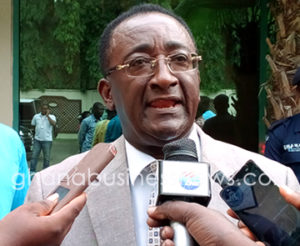Ghana to become self-sufficient in rice and soya bean production – Minister
 Ghana is on the path of achieving self-sufficiency in soya bean production by 2020 and rice production by 2023, Dr Owusu Afriyie Akoto, the Minister of Food and Agriculture, has said.
Ghana is on the path of achieving self-sufficiency in soya bean production by 2020 and rice production by 2023, Dr Owusu Afriyie Akoto, the Minister of Food and Agriculture, has said.
He attributed the high level of progress in the production of the two crops in the country to increased demand by farmers for certified seeds and fertilizers as a result of the Government’s subsidy on the inputs.
He said from a national average of 20 per cent self-sufficiency for soya and 50 per cent for rice before 2017, Ghana was now heading towards self-sufficiency in the production of the two crops.
He said under the Government’s flagship programme “Planting for Food and Jobs” (PFJ), certified seeds usage increased from 4,400 metric tonnes (MT) in 2017, to 6,800MT in 2018 and a target of 15,000MT in 2019 was likely to be exceeded, as a result of increasing demand from farmers.
“Fertilizer usage under the programme has also increased from 121,000MT in 2017 to a target of 331,000MT in 2019, with the national fertilizer use per hectare increasing from 8kg per hectare in 2017 to about 20kg per hectare in 2018,” Dr Akoto remarked on Monday at the Peer to Peer Learning Event of the new Leadership for Agriculture Platform (L4AG).
“For the first time, Ghana exported over 150,000MT of foodstuffs, mainly cereals, to neighbouring countries. This has resulted in the creation of some one million jobs in the rural economy.”
The forum was organised by the African Development Bank (AfBD), with the support of the Rockefeller Foundation and the Bill and Melinda Gates Foundation (BMGF).
Since 2017, the AfDB’s L4AG Platform, has brought high-level and influence government and private sector leaders together for dialogue, advocacy and policy formulation to strengthen Africa’s agriculture sector.
The L4AG Platform has been redesigned to be more effective, with additional focus on change champions and priority themes.
The Learning Event brought a large team of Ministers from other African countries to peer review and share their peculiar experiences relating to agriculture and its role in our respective economies.
Dr Akoto said agriculture in Ghana was recognised as the mainstay of the economy with a greater impact on poverty reduction, compared to other sectors.
He said since 2017, Government had been prosecuting its agricultural transformation agenda by rolling out several modules under the PJF.
Three modules, which had been launched under PFJ and were at various stages of implementation, include the Food Crop Module, Planting for Export and Rural Development and Rearing for Food and Jobs.
He said two other modules; Greenhouse Villages and Mechanizing for Food and Jobs would be launched within the next six months.
“It is important to mention that since 2017, significant yield increases have been recorded for selected crops; maize yields has increased by 67 per cent, from 1.8 metric tonnes per hectare to 3.0 metric tonnes per hectare; rice yield increased by 48 per cent from 2.7 metric tonnes per hectare to 4.0 metric tonnes per hectare and soya yield increased by 150 per cent from one metric tonnes per hectare to 2.5 metric tonnes per hectare.”
He said this among other factors resulted in a sector Gross Domestic Product (GDP) growth rate of 6.1 per cent in 2017, 4.8 per cent in 2018 (rebased) and 7.1 per cent in 2019, making agriculture the sector with the highest growth rate in recent times in Ghana.
“It is worthy to note, that in 2019, agriculture with the GDP growth rate of 7.1 per cent has unprecedentedly overtaken the service sector (6.1 per cent), a one in a million stride in many years,” the Minister said.
Mr Martin Fregene, Director, Department of Agriculture and Agro-Industry, AfDB, said agriculture had to be private sector-led and public sector enabled; declaring that, the Government must provide the policy and enabling environment for the private sector to thrive.
Mr Nick Austin, Director, Agricultural Development, BMGF, said the Foundation was investing in agriculture because they viewed it as a pathway of lifting people out of poverty.
Source: GNA
